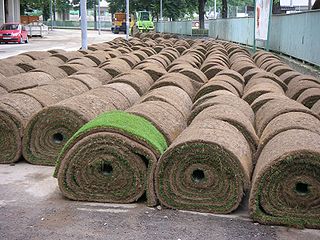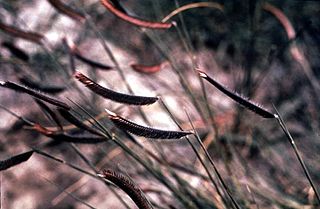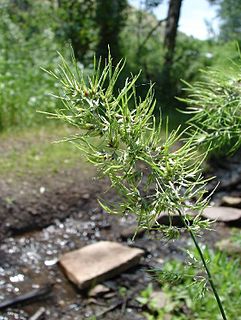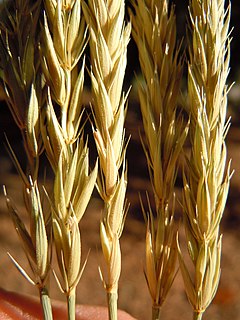
Timothy is an abundant perennial grass native to most of Europe except for the Mediterranean region. It is also known as timothy-grass, meadow cat's-tail or common cat's tail. It is a member of the genus Phleum, consisting of about 15 species of annual and perennial grasses.

Poa pratensis, commonly known as Kentucky bluegrass, smooth meadow-grass, or common meadow-grass, is a perennial species of grass native to practically all of Europe, North Asia and the mountains of Algeria and Morocco. Although the species is spread over all of the cool, humid parts of the United States, it is not native to North America. The Spanish Empire brought the seeds of Kentucky bluegrass to the New World in mixtures with other grasses. In its native range, Poa pratensis forms a valuable pasture plant, characteristic of well-drained, fertile soil. It is also used for making lawns in parks and gardens and has established itself as a common invasive weed across cool moist climates like the Pacific Northwest, and Northeastern United States. When found on native grasslands in Canada, for example, it is considered an unwelcome exotic plant, and is indicative of a disturbed and degraded landscape.

Sod, also known as turf, is grass. When harvested into rolls it is held together by its roots and a thin layer of soil.

Lolium is a genus of tufted grasses in the bluegrass subfamily of the grass family. It is often called ryegrass, but this term is sometimes used to refer to grasses in other genera.

Oryzopsis hymenoides is a cool-season, perennial bunchgrass with narrow, rolled leaf blades. It is native to western North America east of the Cascades from British Columbia and Alberta south to southern California, northeastern Mexico, and Texas.

Ornamental grasses are grasses grown as ornamental plants. Ornamental grasses are popular in many colder hardiness zones for their resilience to cold temperatures and aesthetic value throughout fall and winter seasons.

Bouteloua curtipendula, commonly known as sideoats grama, is a perennial, short prairie grass that is native throughout the temperate and tropical Western Hemisphere, from Canada south to Argentina.

Echinochloa crus-galli is a type of wild grass originating from tropical Asia that was formerly classified as a type of panicum grass. It is commonly known as cockspur, barnyard millet, Japanese millet, water grass, common barnyard grass, or simply "barnyard grass". This plant can grow to 60" in height and has long, flat leaves which are often purplish at the base. Most stems are upright, but some will spread out over the ground. Stems are flattened at the base. The seed heads are a distinctive feature, often purplish, with large millet-like seeds in crowded spikelets.

Bouteloua gracilis, the blue grama, is a long-lived, warm-season (C4) perennial grass, native to North America.

Hordeum jubatum, with common names foxtail barley, bobtail barley, squirreltail barley, and intermediate barley, is a perennial plant species in the grass family Poaceae. It occurs wild mainly in northern North America and adjacent northeastern Siberia. However, as it escaped often from gardens it can be found worldwide in areas with temperate to warm climates, and is considered a weed in many countries. The species is a polyploid and originated via hybridization of an East Asian Hordeum species with a close but extinct relative of Californian H. brachyantherum. It is grown as an ornamental plant for its attractive inflorescences and when done flowering for its infructescence.

Elymus canadensis, commonly known as Canada wild rye or Canadian wildrye, is a species of wild rye native to much of North America. It is most abundant in the central plains and Great Plains. It grows in a number of ecosystems, including woodlands, savannas, dunes, and prairies, sometimes in areas that have been disturbed.

Elymus glaucus is a species of grass known as blue wild rye or blue wildrye. This grass is native to North America from Alaska to New York to northern Mexico. It is a common and widespread species of wild rye.

Leymus condensatus, the giant wildrye, is a wild rye grass native to eastern Oregon, California and northern Mexico.

Poa bulbosa is a species of grass known by the common names bulbous bluegrass or bulbous meadow-grass. It is native to Eurasia and North Africa, but it is present practically worldwide as an introduced species. It is widespread in the United States and southern Canada. It was introduced to the eastern United States around 1906 and the western US in 1915 as a contaminant in shipments of alfalfa seed. It was intentionally planted on both the east and west coasts to control weeds and prevent erosion. Today it is a common grass across the continent and is a noxious weed in some areas. It is a sturdy, hardy, persistent, aggressive grass that easily outcompetes many other plants and becomes the dominant species in disturbed habitat types, such as overgrazed fields.

Leymus salina is a species of grass known as Salina wildrye, Salina Pass wild rye, and saline wildrye. It is native to the western United States and is named for its type locality: Salina Pass, Utah.

Psathyrostachys juncea is a species of grass known by the common name Russian wildrye. It was formerly classified as Elymus junceus. It is native to Russia and China, and has been introduced to other parts of the world, such as Canada and the United States. Psathyrostachys juncea is a great source of food for grazing animals, as it has high nutrition value in its dense basal leaves, even in the late summer and autumn seasons. This species can grow and prosper in many harsh environments, making it an ideal candidate for improvement as it can grow in areas were farming is difficult. This species is a drought-resistant forage plant and can survive during the cool seasons. It is also a cross-pollinator and is self-sterile. This means that P. juncea cannot self-fertilize; it must find another plant of the same species with which to exchange gametes. Self-sterilization increases the genetic diversity of a species.

Leymus angustus is a species of grass known by the common name Altai wildrye. It is native to Asia and Europe and it is cultivated elsewhere as a pasture grass, especially in Canada.

Leymus multicaulis, also known as manystem wild rye or manystem lyme grass, is a species of the genus Leymus. The species name of manystem wild rye, multicaulis, suggests the “many stems” of the species. Leymus multicaulis is considered a type of grass. Manystem wild rye has only one cotyledon in each of its seeds. The xylem and phloem within the roots are arranged in a ring pattern. The vascular bundles are scattered throughout the stem. These traits make Leymus multicaulis a monocot. Leymus multicaulis is a flowering plant, or angiosperm.

Oplismenus undulatifolius, commonly known as wavyleaf basketgrass, is a species of perennial grass from the family Poaceae that is native to Eurasia, specifically Southern Europe through Southern Asia. Due to its invasive nature, it can be found in countries such as Pakistan, China, Japan, Korea, India, Australia, South Africa, and has since been introduced to the Mid-Atlantic United States. There are no recognized subspecies in Catalogue of Life.

Alysicarpus vaginalis is a species of flowering plant in the legume family, Fabaceae. It is native to parts of Africa and Asia, and it has been introduced to other continents, such as Australia and the Americas. It is cultivated as a fodder for livestock, for erosion control, and as a green manure. Common names include alyce clover, buffalo clover, buffalo-bur, one-leaf clover, and white moneywort.




















